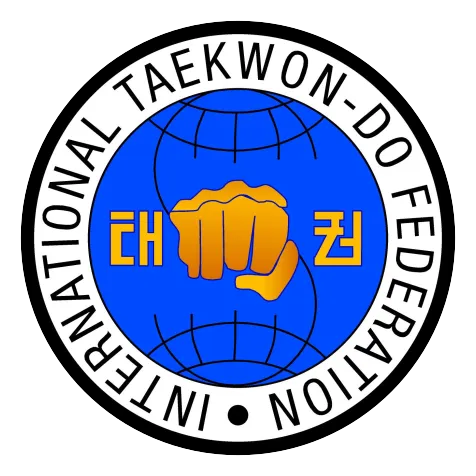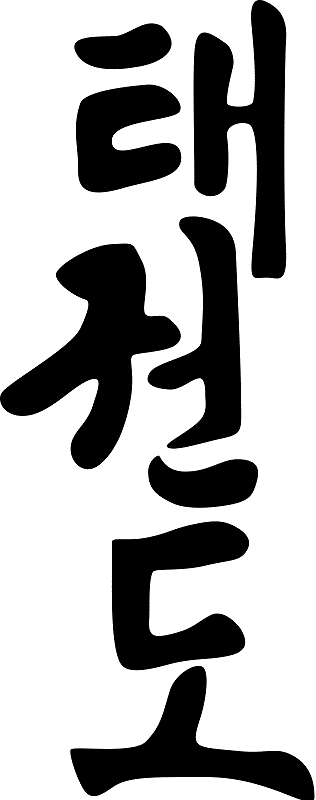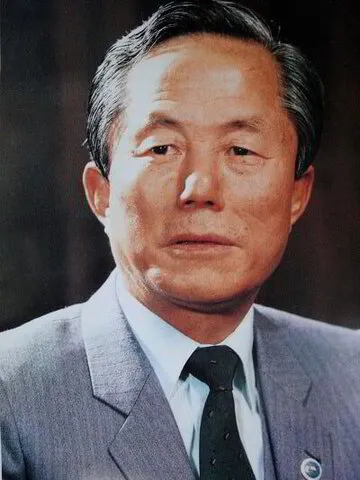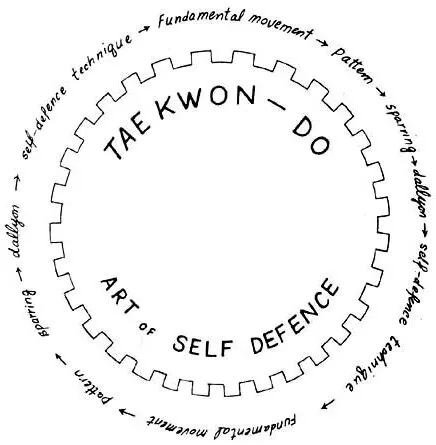About Taekwon-Do
What is Taekwon-Do?
Taekwon-Do (Also written Taekwondo or Tae Kwon Do) is the Korean art of self-defence. It is primarily a striking martial art utilizing the hands and feet for attack and defence. Its training methods are composed of various elements, and it's most well-known for its vast array of skilled and devastating kicks.
The simple translation of Taekwon-Do means:
TAE: to kick or to fly with the foot
KWON: Fist
DO: Art/Way/Method
Taekwon-Do is, therefore, the art of foot and fist fighting.
Taekwon-Do, though, is more than just fighting. The Do or Way in Taekwon-Do also emphasizes moral culture and philosophy, striving to create a more peaceful world.
History of Taekwon-Do
Taekwon-Do officially came into being on 11 April 1955. It was founded by Gen. Choi Hong Hi, a South Korean military General who had spent years developing it and would continue to develop it until his passing in 2002.
Initially, Gen. Choi grew Taekwon-Do through the South Korean military, where he had a lot of influence. He formed the International Taekwon-Do Federation (ITF) on 22 March 1966. He travelled the world with his team of "superhumans," performing fantastic martial arts demonstrations, the likes of which had never been seen before. The world was captivated by these unbelievable feats, and Taekwon-Do spread like wildfire. Today, there are Taekwon-Do organizations in almost every country in the world, which have tens of millions of active participants, more than any other martial art.
A Martial Art for Everyone
Gen. Choi taught his martial arts to anyone willing to learn, regardless of religion, race, or political affiliation. He envisioned Taekwon-Do as a conduit that would break down barriers between people and create a more peaceful world.
Taekwon-Do Today
Today, Taekwon-Do has got many different branches. It was an enigma that could not be contained, and many “borrowed” the name, forming different styles with a myriad of objectives, one branch being accepted into the Olympic Games.
ITF STANDS FOR INTERNATIONAL TAEKWON-DO FEDERATION.
ITF TAEKWON-DO IS ALSO KNOWN AS ORIGINAL TAEKWON-DO OR TRADITIONAL TAEKWON-DO
WHAT IS ITF TAEKWON-DO?
Is ITF Taekwon-Do a style?
The ITF (International Taekwon-Do Federation) is the international governing body associated with Gen. Choi Hong Hi's Taekwon-Do style. Usually, when you ask what type of Taekwon-Do members of this organization perform, they answer "ITF." So, ITF is not a style but an organization that runs parallel with a particular style.
Original Taekwon-Do
ITF-style Taekwondo is the original Taekwon-Do created by its founding father, General Choi Hong Hi (1918-2002). General Choi named his new martial art "Taekwon-Do" on 11 April 1955. He spread his martial art through the South Korean military, which gave Taekwon-Do its rapid growth in the early years.
International Taekwon-Do Federation
On 22 March 1966, General Choi founded the first international governing body for Taekwon-Do, the International Taekwon-Do Federation (ITF). He thus enabled his martial art to implement a set curriculum and keep standards on an international level. At this time, Gen. Choi travelled with his demonstration team of superhumans to spread and promote his martial art. Taekwon-Do associations opened and affiliated with the ITF in almost every country in the world.
Other World Taekwon-Do Bodies
Due to various political events and fallings out, in 1973, his rivals formed another international body. It was named the World Taekwondo Federation (WTF). It has since renamed itself World Taekwondo (WT) (2017) due to negative connotations associated with the acronym. The patterns, techniques, traditional sparring, and competition sparring systems were all changed to the point where they no longer resembled Gen. Choi's Taekwon-Do. Since then, all types of martial arts have cropped up, calling themselves Taekwondo. Gen. Choi never acknowledged any other style of Taekwon-Do. They may have borrowed the name but not the technique.
Body, Mind and Soul
Original Taekwon-Do (ITF) has solid military roots. Its training regimen is excellent for the body, mind, and soul. Its effectiveness for self-defence is unprecedented. There is also a significant sporting aspect to this martial art for those who are that way inclined.
The Magua Taekwon-Do School is an officially recognized ITF school. We are licensed by the International Taekwon-Do Federation.
ITF Licence #590
“HERE I LEAVE TAEKWON-DO FOR MANKIND AS A TRACE OF A MAN OF THE LATE 20TH CENTURY. THE 24 PATTERNS REPRESENT 24 HOURS A DAY OR ALL MY LIFE.“
– GEN. CHOI HONG HI
Gen. Choi Hong Hi devoted his life to the development and spread of Taekwon-Do throughout the world.
Due to his efforts, Taekwon-Do can be found in just about every country in the world. He believed that everyone should be able to train, regardless of religious, political and social ideologies.
“I shall build a more peaceful world”
ITF TAEKWON-DO TODAY
Since Gen. Choi’s passing in 2002, Grand Master (GM) Choi Jung Hwa has led the ITF into the future as its president.
GM Choi Jung Hwa is the son of Gen. Choi Hong Hi. He is also sometimes referred to as the son of Taekwon-Do, or brother to Taekwon-Do. From an early age, Gen.Choi groomed him to lead Taekwon-Do. Under his father’s watchful eye, he ate, slept and breathed Taekwon-Do. He travelled everywhere with his father, assisting, demonstrating and promoting Taekwon-Do around the world.
Today he continues, as his father did before him, spreading, educating and preserving the true spirit of Taekwon-Do. He is the torch-bearer and carrier of Gen. Choi’s legacy.
Composition of Taekwon-Do
(Taekwon-Do Goosung)
Taekwon-Do is composed of fundamental movements, patterns, dallyon, sparring and self-defence techniques that are so closely related that it is impossible to segregate one phase of instruction from another.
Fundamental movements are necessary for sparring and patterns, while both patterns and sparring are indispensable for perfection of fundamental movements.
In the illustration, one can see it is difficult to distinguish the beginning of the cycle from the end. There is, in fact, like the Deity, no beginning or end. A student will find that he will have to return time and time again to the beginning fundamental movements to perfect his advanced sparring and self-defence techniques.
Each fundamental movement, in most cases, represents and attack or defence against a particular target area or definite action of an imaginary opponent or opponents. It is necessary to learn as many fundamental movements as possible and fit them into complete proficiency so the student can meet any situation in actual combat with confidence. The pattern actually places the student in a hypothetical situation where he must avail himself to defence, counterattack, and attack motions, against several opponents. Through constant practice of these patterns, the attack and defence become a conditioned reflex movement. Power and speed must be developed to such a high degree that only one single blow is needed to stop an opponent, so the student can shift stance and block or attack another opponent. Each pattern is different from the other in order to develop reaction against changing circumstances.
Once the basic patterns are mastered, the student then begins to physically apply the skill obtained from fundamental patterns and movements to sparring against actual moving opponents.
Collaterally with sparring, the student must begin to develop his body and toughen his attacking and blocking tools so he is able to deliver maximum damage in actual combat. Once a student has applied himself to fundamental movements, patterns, sparring and dallyon, then the time has arrived for the student to test his coordination, speed, balance, and concentration against spontaneous attacks: ie. self-defence. The student will constantly find himself returning, however, to his fundamentals even when he has achieved the highest possible degree of self-defence techniques. As in military training, Taekwon-Do progression follows a certain parallel:
1. Fundamental Movements = Individual soldier’s basic training
2. Dallyon = Maintenance of equipment
3. Patterns = Platoon tactics
4. Sparring = Field exercises in simulated combat conditions
5. Self-defence = Actual Combat
Reproduced from “Taekwon-Do” (The Korean Art of Self Defence) also known as The Condensed Encyclopaedia.
Fifth Edition 1999, All rights reserved
Copyright 1988, 1991, 1992, 1995, 1999 General Choi, Hong Hi
TAEKWON-DO MORAL CULTURE
Taekwon-Do Oath
- I shall observe the Tenets of Taekwon-Do.
- I shall respect my instructors and seniors.
- I shall never misuse Taekwon-Do.
- I shall be a champion of freedom and justice.
- I shall build a more peaceful world
TENETS OF TAEKWON-DO
COURTESY (Ye Ui)
It can be said that courtesy is an unwritten regulation prescribed by ancient teachers of philosophy as a means to enlighten human beings while maintaining a harmonious society. It can further be as an ultimate criterion required of a mortal.
Taekwon-Do students should attempt to practice the following elements of courtesy to build up their noble character and to conduct the training in an orderly manner as well.
1) To promote the spirit of mutual concessions
2) To be ashamed of one's vices, contempting those of others
3) To be polite to one another
4) To encourage a sense of justice and humanity
5) To distinguish instructor from student, senior from junior, and elder from younger
6) To behave oneself according to etiquette
7) To respect others' possessions
8) To handle matters with fairness and sincerity
9) To refrain from giving or accepting a gift when in doubt
INTEGRITY (Yom Chi)
In Taekwon-Do, the word integrity assumes a looser definition than the one usually presented in Webster's dictionary. One must be able to define right and wrong and have a conscience, if wrong, to feel guilt. Listed are some examples where integrity is lacking:
1) The instructor who misrepresents himself and his art by presenting improper techniques to his students because of a lack of knowledge or apathy.
2) The student who misrepresents himself by "fixing" breaking materials before demonstrations.
3) The instructor who camouflages bad technique with luxurious training halls and false flattery to his students.
4) The student who requests ranks from an instructor or attempts to purchase them.
5) The student who gains rank for ego purposes or the feeling of power.
6) The instructor who teaches and promotes his art for materialistic gains.
7) The students whose actions do not live up to his words.
8) The student who feels ashamed to seek opinions from his juniors.
PERSEVERANCE (In Nae)
There is an old Oriental saying, "Patience leads to virtue or merit, One can make a peaceful home by being patient for 100 times." Certainly, happiness and prosperity are most likely brought to the patient person. To achieve something, whether it is a higher degree or the perfection of a technique, one must set his goal, then constantly persevere. Robert Bruce learned his lesson of perseverance from the persistent efforts of a lowly spider. It was this perseverance and tenacity that finally enabled him to free Scotland in the fourteenth century. One of the most important secrets to becoming a leader of Taekwon-Do is to overcome every difficulty by perseverance. Confucius said, "one who is impatient in trivial matters can seldom achieve success in matters of great importance."
SELF CONTROL (Guk Gi)
This tenet is extremely important inside and outside the dojang, whether conducting oneself in free sparring or in one's personal affairs. A loss of self-control in free sparring can prove disastrous to both student and opponent. An inability to live and work within one's capability or sphere is also a lack of self-control.
According to Lao-Tzu the term "stronger is the person who wins over oneself rather than someone else."
INDOMITABLE SPIRIT (Baekjool Boolgool)
"Here lie 300, who did their duty," a simple epitaph for one of the greatest acts of courage known to mankind. Although facing the superior forces of Xerxes, Leonidas and his 300 Spartans at Thermopylae showed the world the meaning of indomitable spirit. It is shown when a courageous person and his principles are pitted against overwhelming odds.
A serious student of Taekwon-Do will at all times be modest and honest. If confronted with injustice, he will deal with the belligerent without any fear or hesitation at all, with indomitable spirit, regardless of whosoever and however many the number may be.
MAGUA TAEKWON-DO
Take the First Step on Your Taekwon-Do Journey
We would be thrilled to meet with you. Please feel free to schedule your appointment to discuss your requirements with us. We look forward to seeing you.






